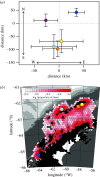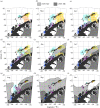Coastal regions of the northern Antarctic Peninsula are key for gentoo populations
- PMID: 33497589
- PMCID: PMC7876601
- DOI: 10.1098/rsbl.2020.0708
Coastal regions of the northern Antarctic Peninsula are key for gentoo populations
Abstract
Southern Ocean ecosystems are rapidly changing due to climate variability. An apparent beneficiary of such change in the western Antarctic Peninsula (WAP) is the gentoo penguin Pygoscelis papua, which has increased its population size and expanded its range southward in the last 20 years. To better understand how this species has responded to large-scale changes, we tracked individuals during the non-breeding winter period from five colonies across the latitudinal range of breeding sites in the WAP, including from a recently established colony. Results highlight latitudinal gradients in movement; strong associations with shallow, coastal habitats along the entire Antarctic Peninsula; and movements that are independent of, yet constrained by, sea ice. It is clear that coastal habitats essential to gentoo penguins during the breeding season are similarly critical during winter. Larger movements of birds from northern colonies in the WAP further suggest that leap-frog migration may influence colonization events by facilitating nest-area prospecting and use of new haul-out sites. Our results support efforts to develop a marine protected area around the WAP. Winter habitats used by gentoo penguins outline high priority areas for improving the management of the spatio-temporally concentrated krill (Euphausia superba) fishery that operates in this region during winter.
Keywords: Pygoscelis papua; climate change; range expansion; satellite telemetry.
Conflict of interest statement
We declare we have no competing interests.
Figures


Similar articles
-
Marine pelagic ecosystems: the west Antarctic Peninsula.Philos Trans R Soc Lond B Biol Sci. 2007 Jan 29;362(1477):67-94. doi: 10.1098/rstb.2006.1955. Philos Trans R Soc Lond B Biol Sci. 2007. PMID: 17405208 Free PMC article. Review.
-
Influence of migration range and foraging ecology on mercury accumulation in Southern Ocean penguins.Sci Total Environ. 2024 Nov 15;951:175154. doi: 10.1016/j.scitotenv.2024.175154. Epub 2024 Aug 15. Sci Total Environ. 2024. PMID: 39153634
-
Divergent trophic responses of sympatric penguin species to historic anthropogenic exploitation and recent climate change.Proc Natl Acad Sci U S A. 2019 Dec 17;116(51):25721-25727. doi: 10.1073/pnas.1913093116. Epub 2019 Dec 2. Proc Natl Acad Sci U S A. 2019. PMID: 31792174 Free PMC article.
-
Antarctic krill fishery effects over penguin populations under adverse climate conditions: Implications for the management of fishing practices.Ambio. 2021 Mar;50(3):560-571. doi: 10.1007/s13280-020-01386-w. Epub 2020 Sep 26. Ambio. 2021. PMID: 32979187 Free PMC article.
-
Climate change and Southern Ocean ecosystems I: how changes in physical habitats directly affect marine biota.Glob Chang Biol. 2014 Oct;20(10):3004-25. doi: 10.1111/gcb.12623. Epub 2014 Jun 30. Glob Chang Biol. 2014. PMID: 24802817 Review.
Cited by
-
Availability to predators and a size structure of the Antarctic krill Euphausia superba in the 48.1 CCAMLR subarea.Sci Rep. 2024 Sep 15;14(1):21538. doi: 10.1038/s41598-024-72895-x. Sci Rep. 2024. PMID: 39278953 Free PMC article.
-
Adélie penguins north and east of the 'Adélie gap' continue to thrive in the face of dramatic declines elsewhere in the Antarctic Peninsula region.Sci Rep. 2023 Feb 13;13(1):2525. doi: 10.1038/s41598-023-29465-4. Sci Rep. 2023. PMID: 36782007 Free PMC article.
-
From acidophilic to ornithogenic: microbial community dynamics in moss banks altered by gentoo penguins.Front Microbiol. 2024 Mar 7;15:1362975. doi: 10.3389/fmicb.2024.1362975. eCollection 2024. Front Microbiol. 2024. PMID: 38525081 Free PMC article.
-
Acute bottlenecks to the survival of juvenile Pygoscelis penguins occur immediately after fledging.Biol Lett. 2020 Dec;16(12):20200645. doi: 10.1098/rsbl.2020.0645. Epub 2020 Dec 16. Biol Lett. 2020. PMID: 33321063 Free PMC article.
References
-
- Parkinson CL, DiGirolamo NE. 2016. New visualizations highlight new information on the contrasting Arctic and Antarctic sea-ice trends since the late 1970s. Remote Sens. Environ. 183, 198–204. (10.1016/j.rse.2016.05.020) - DOI
-
- Henley SF, et al. . 2019. Variability and change in the west Antarctic Peninsula marine system: research priorities and opportunities. Prog. Oceanogr. 173, 208–237. (10.1016/j.pocean.2019.03.003) - DOI
MeSH terms
LinkOut - more resources
Full Text Sources
Other Literature Sources

